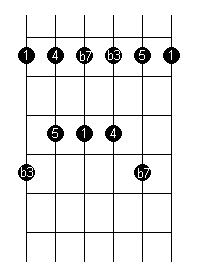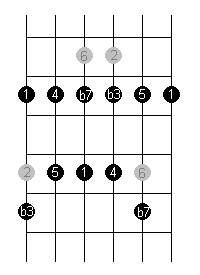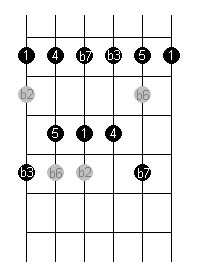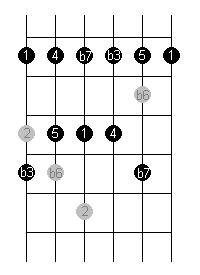
We've already seen an introduction to the Major Pentatonic scale. Remember how in major scale harmony, a major scale's relative natural minor (the minor scale with the same notes as the relative major, from a different root note) can be found by taking the notes of the major scale, starting on the sixth degree of the major scale. The same thing works with pentatonic scales too.
Consider the C major pentatonic scale, C D E G A. The major pentatonic scale has the formula 1-2-3-5-6, which means that we can use the 6th degree (A) and rearrange these notes using A as a starting point. Always remember that the numbers refer to how the note names relate back to the major scale, so here 6 means the note that occurs 6th in the C major scale, not 6th in the C major penatonic (which only has 5 notes, anyway).
Re-arranging these notes from the C major pentatonic from an A root note gives us A C D E G. The name for this scale is the minor pentatonic (for fairly obvious reasons). Let's check out how the notes of this scale relate to the notes of the A major and A natural minor scales:
| And here's a useful shape for the minor pentatonic scale: |  |
Similar to the major pentatonic, the minor pentatonic contains notes which are common to all three minor modes of the major scale (check out a tutorial elsewhere if you're not familiar with major scale modes).
 Dorian Mode |
 Phrygian Mode |
 Aeolian Mode |
|---|
To round things off, it's worth mentioning a very useful variation of the minor pentatonic scale. When a flattened fifth is added to the minor pentatonic scale, we get a new scale called the blues scale.
Technically speaking this is the minor blues scale (there is a major blues scale as well) but as this is the most prolific blues scale, the word 'minor' very often gets dropped - it's kind of taken for granted that the phrase 'blues scale' refers to the minor version of the scale.
How useful did you find this tutorial?
| Product/Info... | PhatPhish Application | | | Product Help | | | GUPPY - PhatPhish for the web | | | About The Author |
|---|
| Get Stuff... | Download PhatPhish | | | Mechandise | | | Blank Stave And Tab Sheets | | | Tutorials |
|---|
| Do Stuff... | Register | | | Feedback | | | Links | | | Donate | | | Ask A Question |
|---|
| Social Media... | YouTube | | | | |
|---|
| Promote... | Spread The Word | | | Posters/Flyers |
|---|
| Play... | PhatPhish Picks - Boutique Plectrums |
|---|
| ©2002-2022, Dave Dixon / CyberFlotsam http://www.cyberflotsam.com |